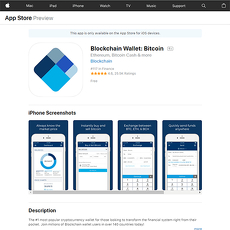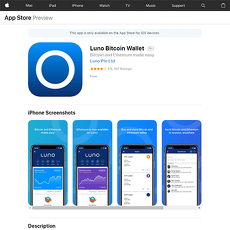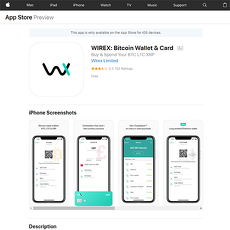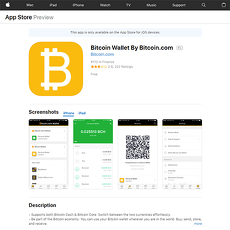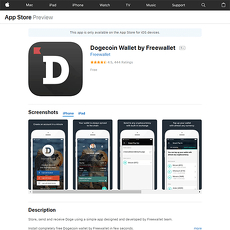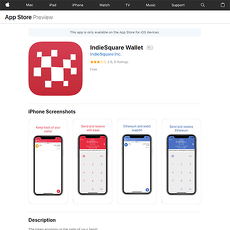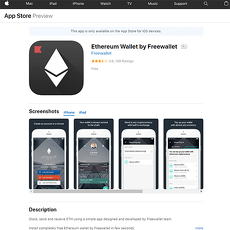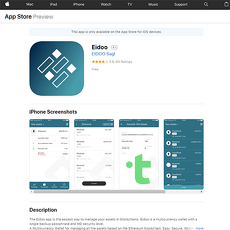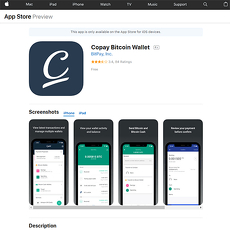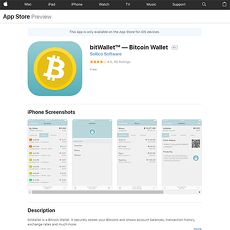Monero Wallet by Freewallet Review
Monero Wallet by Freewallet
itunes.apple.com
Monero Wallet by Freewallet Review Guide: Is This the Easiest Way to Manage XMR on iOS?
Is your crypto truly safe on your phone or do you just think it is? If you’ve recoiled from horror stories about hacked wallets or have felt overwhelmed by confusing wallet apps, it’s not just you. With privacy coins like Monero (XMR), this question matters even more—because your whole reason for using Monero might be privacy, security, and pure control.
Why Picking a Crypto Wallet Feels Like a Gamble
Let’s be honest—searching for the perfect iOS crypto wallet often feels like wandering through a digital minefield:
- Security: Can you trust a wallet to actually protect your coins—not just talk about it?
- Interface headaches: How many taps does it take to send funds, really?
- Privacy: If Monero is built for privacy, will your app choice leak your identity or habits?
- Support: If something goes wrong, is anyone actually on your side?
A recent Chainalysis study pointed out a sharp spike in wallet scams and hacks, making “wallet choice” far more than a technical decision—it's now a serious security strategy. When every app claims “industry-leading protection” without ever showing how, it’s tough to filter solid options from those you’ll regret.
What This Guide Will Actually Do
Instead of parroting sales pitches, let’s cut through the hype. By the time you finish, you'll know:
- If the Monero Wallet by Freewallet matches your real-life needs—not just the dream wallet in every app store ad.
- What features make it special (and what might annoy you) if you care about everyday security and usability on iOS.
- How to actually get started or ask the same questions as real users who don’t have hours to waste on Reddit threads.
What’s Coming Next—And Why You Should Care
Curious if Monero Wallet by Freewallet stands up to iOS heavyweights like Exodus or Trust Wallet—especially for Monero diehards or privacy-first users?
In a world where your crypto security is as strong (or weak) as the wallet you use, making the wrong move can cost you more than just coins. If you want:
- The easiest possible way to store and send XMR from your iPhone
- A wallet experience that won’t make you read a manual or chase support tickets
- Real answers from someone who actually checks how things work—not just what the brochure claims
You’re exactly where you need to be. And if you want to see how Freewallet compares to the top picks for Bitcoin and altcoins, I’ve got game-changing resources and honest rankings—so you can cross-check.
Still trying to separate what’s trustworthy from what’s trendy? Stay tuned, because up next: What the Monero Wallet by Freewallet actually is, how it’s built, and if it really earns its place in your XMR toolkit. Would you gamble your privacy on the wrong app? Let’s answer that in the next section.
Understanding Monero Wallet by Freewallet: What Is It?
Picture this: You’re hunting for a wallet on iOS that actually works with Monero (XMR), the ultimate privacy coin—something built for real-world, daily use, not just hype. That’s where Monero Wallet by Freewallet comes into play. At its core, it’s a dedicated app designed to make handling XMR as seamless as swapping memes on your phone. Freewallet’s been around since 2016, and their Monero-specific wallet is hugely popular for good reason: it takes the confusing parts out of crypto and puts privacy-focused features front and center, right where Monero hodlers want them.
“Simplicity is the ultimate sophistication.” — Leonardo da Vinci’s words ring true when your money’s on the line.
Key Features & Supported Functions
So what actually makes this wallet tick? Here’s what stands out when you open the app:
- Security Upgrades First: The app relies on PIN codes, Touch ID, and cloud-level encryption. Most users can sleep a little easier with these baseline protections, even if you aren’t a tech genius.
- Built-In Crypto Exchange: Forget using a separate service just to swap coins. Freewallet lets you exchange Monero for dozens of other cryptos right in the app—no hopping between tabs or risking phishing attacks on suspect websites.
- Cross-Platform Flexibility: While this is the iOS edition, your Monero can be managed on Android or desktop (via Freewallet’s ecosystem), with sync between devices as long as you log in with your credentials.
- No-Brainer Sending & Receiving: QR codes, contact lists, and copy/paste functions make moving Monero simple—even for those infamous 95-character XMR addresses.
- Slick, Minimal Interface: Users consistently praise the uncluttered layout. If you want to check your balance, track a transaction, or send coins, it’s all accessible in just a few taps.
One Redditor summed it up nicely: “If you can use a banking app, you can use Freewallet.” That’s not something you can say about most crypto wallets.
How Does Monero Wallet by Freewallet Handle Your Privacy?
We’ve got to talk privacy—after all, Monero is made for stealth, and there’s a unique expectation when you’re holding XMR. Freewallet advertises encrypted connections and account-level separation (nobody else can peek inside your wallet from within the platform). But there’s a catch: as a custodial wallet, Freewallet holds your private keys, not you. Yes, that’s a mental hurdle for hardcore privacy buffs.
What data does Freewallet collect? You’ll need to hand over a verified email, set a password, and in some scenarios (rare, but possible), you might hit a Know-Your-Customer (KYC) checkpoint if you’re exchanging larger sums or swapping between fiat and crypto. The good news? Your XMR transactions remain off-chain private, as Monero itself is built to hide amounts and wallet addresses on the blockchain.
If absolute, zero-trust privacy is your only priority, this model might give you pause. Still, for the vast majority who want mix of convenience, safety, and basic security hygiene, Freewallet does a solid job—especially for those wary of managing long, complex recovery phrases on their own.
Coin Support and Compatibility
While this review’s all about Monero, you’re not boxed in. Freewallet’s XMR wallet app supports Monero natively, but within the broader Freewallet family, you can manage 40+ popular coins (think Bitcoin, Ethereum, Dogecoin), often from the same account. It’s not a pure multi-coin wallet in this iOS version, but easy swaps mean you aren’t stuck if market winds change overnight.
- Full iOS compatibility: Works perfectly on iPhone and modern iPad models, and syncing across devices with your login is quick.
- Freewallet ecosystem integration: Want to branch out? Use the Multiwallet app or switch devices and your coins are all still accessible.
Bottom line: if you like flexibility without juggling recovery seeds or multiple apps, this could save you a ton of headache (and help prevent accidental losses—something no spreadsheet can fix).
Who Is Monero Wallet by Freewallet For?
This is where a lot of people get caught up. Not every wallet is right for every user. Freewallet’s Monero app is tailored to:
- Crypto Newcomers: If you’ve just discovered Monero and want a wallet where you can’t easily mess up, the hand-holding interface and built-in safety features hit the mark.
- Fans of Convenience: Hate managing private keys or backup files? This wallet will feel like using any other secure app on your phone.
- Cross-Device Jockeys: Switching between iPhone and desktop? Forget manual transfers—keep your XMR synced in one place.
- Basic XMR Users: If your main goal is sending, storing, and occasionally swapping Monero without heavy custom privacy tweaks, you’re in the right place.
But if you’re that friend who encrypts their hard drive, only uses open-source wallets, and won’t even say “crypto” on the phone, the custodial setup may feel like a compromise. For thousands of others, though, it’s a sweet spot between user-friendliness and Monero-specific function.
Security is where things get interesting—and controversial. Want to know exactly how Freewallet handles your keys, what’s actually protecting your XMR, and whether you’ll ever wrestle your funds away from the app itself? Stick around, because up next is the real-world scoop on its safety, reputation, and how it measures up against the top iOS wallet heavyweights. What you discover might have you rethinking everything you’ve heard about “wallet security”…
Security and Safety: Is Monero Wallet by Freewallet Trustworthy?
Let's be real—when it comes to holding Monero on your iOS device, a glossy interface means nothing if you’re constantly worried about security. Nobody wants that “did my crypto just vanish?” gut drop. So, how does Freewallet stack up when your coins are on the line?
How Your Private Keys & Backups Work
If you’re the kind of person who lives by the phrase “not your keys, not your coins,” sit down for this part. Freewallet, like many mobile wallets, is custodial. This means they hold and manage your private keys for you. You don’t get a seed phrase or raw private key access—so control is limited. Instead, you log in and access your coins through their system, not a local, device-only key.
Why do some users still go for it? Convenience. Lose your phone? As long as you can recover your password (and get past 2FA), they’ll let you recover your wallet. But if your top priority is total control and anonymity, this custodial format might give you pause.
Exploring Security Features: Two-Factor, Biometrics, and Beyond
Freewallet doesn’t skimp on at least a basic security layer:
- Two-factor authentication (2FA): Available via SMS, email, or a Google Authenticator-style app, so it takes more than just a password to log in, even if someone compromises your device.
- Biometric login: If your iPhone supports Face ID or Touch ID, you can flip this on in settings for an extra peace of mind.
- Pin codes: Adds another lock screen if you’re especially cautious about anyone picking up your phone.
What about past issues? Some app reviews point out occasional login hiccups, but overall, there hasn’t been any massive breach reported directly by Freewallet users. Still, always keep your app updated—that’s vital with any custodial service.
“The most secure wallet is the one you can actually use correctly, every time.”
What About Scams or Hacking Reports?
The crypto space has a memory like an elephant, and Freewallet’s reputation has been chewed over in forums like Reddit and BitcoinTalk. While you’ll find isolated reports of delays with withdrawals and support frustrations, outright hacks are rare. Problems often tie back to account security lapses—lost passwords, weak 2FA, or phishing attempts.
One user story making the rounds: someone got phished after Googling a fake Freewallet support page and handed over login info. It’s a painful reminder—never share credentials, and always double-check you’re at the official site.
How Does it Compare to Other iOS Wallet Choices?
Let’s quickly stack Freewallet up against others:
- Trust Wallet: Full private key access, non-custodial, but if you lose your seed phrase, you’re out of luck. More responsibility, but more freedom.
- Exodus: Also non-custodial and offers a slick interface. You get your seed backup—and only you control your keys.
- Hardware Wallets (like Ledger or Trezor): The gold standard for “paranoid” storage. Extreme control and maximal security, but less convenience on the go.
So with Freewallet, you’re leaning into convenience and backup safety, while giving up a bit of raw control. That can be a fair trade-off, or a dealbreaker, depending on your risk tolerance and tech comfort.
Before you make that first Monero transaction, you might be wondering: “Does Freewallet make everyday use easy—or will the technical stuff get in the way?” Don’t worry, the next section is all about real-world app experience, with step-by-step tips you’ll wish you’d seen months ago. Ready to see how it really feels to use Freewallet for Monero on your iPhone?
User Experience: Using the App Day-to-Day
Let’s get right to the heart of what matters: What’s it actually like to use Monero Wallet by Freewallet on iOS as your daily driver for XMR? I’m talking setup, moving your first coins, and those extra features that sneak up and make your life either sweet or sour. Spoiler: Not every crypto wallet feels like a puzzle box. Here’s why this one stands out to some (and frustrates others!).
How to Set Up Monero Wallet by Freewallet (Step-by-Step)
Being hit with complicated onboarding is a dealbreaker for many. Fortunately, setting up this app is pretty painless—even for crypto freshmen:
- Download the app straight from the App Store. (Watch out for fakes; only trust the official Freewallet release!)
- Once installed, just tap 'Create Account' and pick your login method. Email, Facebook—you decide.
- The app handholds you as you set a strong password and activate any security extras you want right away.
- You'll be inside your new Monero wallet in less than 2 minutes, with no invasive KYC screens or endless forms.
Real talk: I was impressed with just how quick and brainless this setup felt. If you’ve ever found yourself yelling at your phone trying to back up a seed phrase, you’ll love the simplicity.
Making Transactions: Sending and Receiving Monero
Sending XMR shouldn’t feel risky. Here, it looks like this:
- Tap Send, input your recipient’s Monero address, and the amount (the app checks for valid Monero addresses so those copy-paste nightmares are less likely).
- Double-check—every detail counts! A simple “Preview” step lets you catch any mistakes before you hit Confirm.
- For receiving, just share your wallet’s Monero address or the handy QR code inside the app.
- Transaction status updates are fast and clear, with push notifications so you don’t need to keep checking like a hawk.
“The secret of change is to focus all of your energy, not on fighting the old, but on building the new.” – Socrates
Swapping old habits for new, secure ones in crypto can be easier than you think.
Extra Features: Exchange, Portfolio View, and More
This isn’t just a plain Monero wallet. A couple of bells and whistles stand out:
- Built-in Exchange: Want to swap BTC to XMR or vice versa? The in-app exchange tool means you never need to leave the wallet. Super useful if you want to rebalance your holdings on the fly.
- Portfolio View: See your current holdings, total value, and transaction history all in one swipe. It’s not at the level of a full-blown portfolio app, but it makes tracking your Monero easy—and avoids spreadsheets (unless spreadsheets are your jam).
- Push notifications keep you posted, so you're never left guessing if a transaction has landed or gone out.
This all-in-one dashboard is a major plus, especially if you’re juggling crypto alongside your work or studies. According to a 2023 study by Chainalysis, ease of use and fast notifications are among the top features users say keep them loyal to a wallet app. Intuitive design really does count.
Customer Support and Helpfulness
Here’s where some crypto wallets flop—but Freewallet keeps you covered:
- Live chat (inside the app) for urgent issues—most reps respond in under an hour in my experience.
- Extensive FAQs and guided walk-throughs for common problems. If you ever get stuck, the app lets you search help without leaving your wallet screen.
- Support tickets for trickier stuff—you won’t be sent on a wild goose chase. The team is known for actually closing the loop and not ghosting users, at least according to the latest Trustpilot reviews.
If you’re nervous or new to Monero, knowing real humans are just a tap away can be a game changer.
So, the day-to-day with Monero Wallet by Freewallet can feel surprisingly smooth if you value simplicity mixed with a few smart extras. But now you might be thinking: Is it really safe, and what’s the real story behind the most asked Monero wallet questions out there? Keep reading—next up, I’m putting the spotlight on those burning FAQs and honest answers you won’t find in the app’s brochure.
FAQ: Real Questions People Ask About Monero Wallet by Freewallet
Let’s skip the sales talk and go for real answers. Here are the most common, sometimes tough, sometimes clever, but always honest questions folks ask about using Monero Wallet by Freewallet on iOS. If you Google these, you’ll find all kinds of hot takes and half-answers—but here you’ll get direct info you can actually use.
Is Monero Wallet by Freewallet Safe?
This is the number one thing that keeps popping up—everyone wants to know if Freewallet can be trusted with their Monero. Here’s the straight truth:
- Custodial Setup: Freewallet is a custodial wallet, which means your private keys are kept by them, not on your device. This makes it easy to recover your account if you forget your login—but it also means you need to trust Freewallet’s security measures.
- Security Features: They offer basic protections like PIN locks, biometric access (Face ID/Touch ID on iOS), and email confirmations for sensitive actions. But you’re not fully in control of your keys or coins.
- Community Warnings: Some users have reported slow withdrawal processes or issues with account freezes. Make sure you’re comfortable with a custodial model before jumping in. If self-custody is your thing, you might want another Monero wallet (hardware or open-source apps give full control).
“Not your keys, not your coins”—it’s a mantra for good reason.
Can You Withdraw XMR to Another Wallet Easily?
Transferring your Monero out of Freewallet isn’t difficult, but there’s a process to follow:
- Open the app and select Monero from your portfolio.
- Tap ‘Send,’ and paste the external Monero wallet address (check and double-check—XMR addresses are long!).
- Enter the amount and confirm the transaction.
There are network (miner) fees—these change based on current Monero network usage. Freewallet sometimes adds an additional service fee (always check before sending). Most withdrawals process within 30-90 minutes, but some users report delays, especially with large amounts. If you ever feel stuck, reach out to support. Expect delays in peak times as anti-fraud reviews may kick in for new users.
Does Freewallet Let You Keep Your Private Keys?
This one’s major: No, Freewallet does NOT give you your Monero private keys. It’s a hosted/custodial wallet—meaning they hold the keys (and the coins) for you. You get a username and password, not a private key or recovery phrase. This makes things super simple if you’re new… but if you want true independence, you’ll want to look elsewhere.
Why does this matter? With your own keys, you’re in total control. Lose your device? No problem, you just restore from your seed phrase in a new app. With custodial services, if the provider goes offline or gets hacked, you may have a tough time getting your funds back. For some, that’s a risk not worth taking.
What Fees Will You Pay?
Here’s what to expect on the fee side:
- Network Fees: You always pay the regular Monero miner fee for sending transactions. This is paid to Monero miners, not Freewallet.
- Service Fees: In certain cases (like instant off-chain swaps), Freewallet adds a small processing fee. It’s usually less than what you’ll pay on exchanges, but higher than pure non-custodial wallets.
- All-in-all: Expect to pay a tiny bit more for convenience and ease of use. If you want rock-bottom costs, look for non-custodial and open-source alternatives.
Alternatives to Consider & Helpful Resources
Maybe you’re reading this and thinking, “Okay, Freewallet sounds easy—but I’m not wild about custodial wallets.” You’ve got choices! Take some time to check out:
- Ultimate Guide to Best iOS Bitcoin Wallet and Altcoin Wallets (with tons of non-custodial and hardware picks).
- Bookmark Cryptolinks.com for daily wallet reviews, step-by-step how-tos, and insider crypto tools I actually use.
Want open-source? Look into Cake Wallet for Monero or even hardware options like Ledger (though XMR setup can take a minute). Want a multi-coin wallet instead? Think Trust Wallet or Exodus for iOS, ideal if you hold more than Monero.
“The right wallet is the one that fits your strategy—and makes your crypto life easier, not harder.”
Still got questions? You’re not alone. Picking wallets for privacy coins like Monero isn’t one-size-fits-all. Wondering if Freewallet is a smart move for you personally, or want to know how you can make your XMR even safer after setup? Keep going—I’ll untangle those scenarios and pit my honest take against the competition in the next part. Stick around, because your perfect wallet match (and your crypto safety playbook) are coming up next!
Should You Use Monero Wallet by Freewallet? My Honest Take
Let’s get straight to it—choosing a crypto wallet is personal. After spending hours with Monero Wallet by Freewallet on iOS, a few things really stood out for me, both good and not-so-good.
If you’re all about speed, convenience, and don’t mind letting someone else handle your keys, Freewallet feels almost like using PayPal for Monero. The design is friendly for beginners, with quick swaps and an easy account setup. But if you value absolute privacy and self-custody above everything, this wallet doesn’t give you that last bit of control you may want. There’s always a balance between ease and ownership. With Freewallet, the scales tip slightly toward ease, but you’ll trade off some privacy and power in return.
- Pros: Fast setup, built-in crypto swaps, sleek interface. Beginners won’t get lost and there’s proper support if you get stuck.
- Cons: Custodial model (they hold your keys), not as open-source or transparent as hardcore XMR fans expect, and occasional user complaints about withdrawal delays, as seen in Reddit and Trustpilot reviews.
Who gets the most value? If you’re new to Monero, need a handy hot wallet for small amounts, or want to combine multiple currencies in one place, this is a practical option—just don’t keep your life savings here. For privacy purists and cold storage die-hards, you might want to stick with more self-sovereign apps or hardware options.
How to Keep Your Monero Even Safer After Choosing a Wallet
Whether you go with Freewallet or something else, keeping your coins safe is non-negotiable. Here’s what works best in the real world:
- 2FA, Always: Turn on two-factor authentication in Freewallet (or any wallet) the moment you set up your account. This simple move blocks most casual attackers.
- Use a Unique, Strong Password: Research from the Pew Research Center shows that people often reuse passwords. Don’t be “people”—mix numbers, symbols, and make it unique.
- Back Up Your Credentials: Store a backup in a safe, offline place, not in your email or on cloud notes that can be leaked. For custodial wallets, it’s about your login and 2FA codes; for others, it’s your seed phrase.
- Watch for Phishing: Fake sites and emails love to target crypto users. Bookmark the official Freewallet link (freewallet.org) or use only direct App Store links—never Google your way there.
- Stay Updated: Wallet apps update often. Many hacks happen due to old versions with unpatched vulnerabilities.
Following these basics cuts your chances of a bad day to near zero. According to data from Ledger, phishing is still one of the top causes of crypto loss—basic awareness helps.
What Else You Should Know Before You Go
If you’re serious about protecting your crypto, go one step further. Run regular checks on the versions of your wallet app. Make small test withdrawals when you’re using a new wallet—this highlights any delays or glitches early, without risking your main funds. And don’t forget, some custodial wallets might temporarily freeze withdrawals for security checks, usually if you trigger automated flags.
Using Freewallet’s built-in swap for altcoins is handy, but watch the rates. Sometimes, third-party exchange rates can be a little higher than on open exchanges. Compare fees and confirm the network you’re sending XMR to is correct—Monero transactions are final.
Stuck or want something different? My roundups and wallet reviews at Cryptolinks.com list updated guides, alternatives, and how-tos. You’ll even find walkthroughs specifically for privacy-first wallets if you want to branch out.
Final Thoughts: Start Your Monero iOS Journey With Confidence
There’s really no single “right” wallet for everyone. What matters most is matching your comfort zone with your security needs. Freewallet lowers the entry barrier to Monero on iOS, so if it ticks your boxes, jump in—but use it the smart way and stay security-savvy.
Most importantly, don’t rush your choice. Spend as much time picking your wallet as you do choosing your first coin. If you ever need the latest wallet news, tips, or side-by-side comparisons, bookmark https://cryptolinks.com/news/. I’m always adding honest insights to help you stay ahead—so you can confidently handle your crypto, no matter what the market does.



